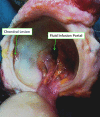Femoroacetabular impingement negates the acetabular labral seal during pivoting maneuvers but not gait
- PMID: 24989124
- PMCID: PMC4294921
- DOI: 10.1007/s11999-014-3760-1
Femoroacetabular impingement negates the acetabular labral seal during pivoting maneuvers but not gait
Abstract
Background: Experimental disruption of the labrum has been shown to compromise its sealing function and alter cartilage lubrication. However, it is not known whether pathological changes to the labrum secondary to femoroacetabular impingement (FAI) have a similar impact on labral function.
Questions/purposes: Does damage to the labrum occurring in association with abnormal femoral morphology affect the labral seal?
Methods: Using 10 fresh cadaveric specimens (mean age 50 years, ±8), we measured the capacity of the central compartment of the hip (the iliofemoral joint) to maintain a seal during fluid infusion, which may help elucidate the function of the labrum during weightbearing. Specimens with and without abnormal femoral morphology (six normal-appearing specimens and four whose geometry suggested cam-type FAI) were tested in postures observed during functional activities, including simulations of normal gait, stooping, and pivoting. Each specimen with FAI morphology exhibited secondary damage of the labrum and the adjacent chondral surface, whereas specimens of normal morphology were undamaged.
Results: Average peak central compartment pressure was reduced during pivoting for specimens with the presence of labral damage secondary to FAI. When placed in pivoting positions, hips with FAI maintained lower fluid pressures within the central compartment compared with intact specimens (15±3 versus 42±8 kPa, respectively; effect size: 1.08 [-0.36 to 2.31]; p=0.007). No differences in peak pressure were observed between groups (FAI versus normal) for postures simulating either gait (21±6 versus 22±4 kPa; p=0.902) or stooping (9±2 versus 8±3 kPa; p=0.775) with the numbers available.
Conclusions: The acetabular seal, quantified by the maximum intraarticular pressure, was reduced during pivoting; however, the seal was maintained during simulated gait and stooping.
Clinical relevance: Because degeneration is progressive with repetitive impingement, loss of the labral seal starts to be seen during pivoting and may progress from there, but in this small-sample cadaver study that evaluated specimens in middle adulthood, the seal remains intact during simulated gait and stooping. Our study suggests that labral damage secondary to cam-type FAI may reduce the ability of the labral to provide an adequate seal of the central compartment of the hip during loading; however, the extent to which this is affected requires further investigation.
Figures




Similar articles
-
The acetabular labrum regulates fluid circulation of the hip joint during functional activities.Am J Sports Med. 2014 Apr;42(4):812-9. doi: 10.1177/0363546514522395. Epub 2014 Feb 20. Am J Sports Med. 2014. PMID: 24557859
-
Labral Reattachment in Femoroacetabular Impingement Surgery Results in Increased 10-year Survivorship Compared With Resection.Clin Orthop Relat Res. 2017 Apr;475(4):1178-1188. doi: 10.1007/s11999-016-5114-7. Clin Orthop Relat Res. 2017. PMID: 27744594 Free PMC article.
-
The Hip Suction Seal, Part II: The Effect of Rim Trimming, Chondrolabral Junction Separation, and Labral Repair/Refixation on Hip Distractive Stability.Am J Sports Med. 2020 Sep;48(11):2733-2739. doi: 10.1177/0363546520941859. Epub 2020 Aug 7. Am J Sports Med. 2020. PMID: 32762632
-
The biomechanical case for labral débridement.Clin Orthop Relat Res. 2012 Dec;470(12):3398-405. doi: 10.1007/s11999-012-2446-9. Clin Orthop Relat Res. 2012. PMID: 22744205 Free PMC article. Review.
-
Femoroacetabular impingement: question-driven review of hip joint pathophysiology from asymptomatic skeletal deformity to end-stage osteoarthritis.J Orthop Traumatol. 2019 Nov 4;20(1):32. doi: 10.1186/s10195-019-0539-x. J Orthop Traumatol. 2019. PMID: 31686267 Free PMC article. Review.
Cited by
-
Hip Labral Reconstruction With a Polyurethane Scaffold: Restoration of Femoroacetabular Contact Biomechanics.Orthop J Sports Med. 2022 Sep 14;10(9):23259671221118831. doi: 10.1177/23259671221118831. eCollection 2022 Sep. Orthop J Sports Med. 2022. PMID: 36119123 Free PMC article.
-
Capsular plication in the non-deformity hip: impact on post-operative joint stability.J Exp Orthop. 2019 Jan 29;6(1):3. doi: 10.1186/s40634-019-0172-x. J Exp Orthop. 2019. PMID: 30694409 Free PMC article.
-
Achieving a Perfectly Spherical Femoroplasty: Pearls, Pitfalls, and Optimal Surgical Technique.Arthrosc Tech. 2020 Feb 21;9(3):e303-e313. doi: 10.1016/j.eats.2019.10.011. eCollection 2020 Mar. Arthrosc Tech. 2020. PMID: 32226736 Free PMC article.
-
The Contribution of Soft Tissue and Bony Stabilizers to the Hip Suction Seal: A Systematic Review of Biomechanical Studies.Am J Sports Med. 2024 Aug;52(10):2657-2666. doi: 10.1177/03635465231208193. Epub 2024 Feb 6. Am J Sports Med. 2024. PMID: 38318815 Free PMC article.
-
Radiographic analysis of subclinical appearances of the hip joint among patients with labral tears.J Orthop Surg Res. 2019 Nov 14;14(1):369. doi: 10.1186/s13018-019-1435-z. J Orthop Surg Res. 2019. PMID: 31727125 Free PMC article.
References
-
- Crawford MJ, Dy CJ, Alexander JW, Thompson MT, Schroder S, Vega C, Patel R, Miller A, McCarthy JC, Lowe W, Noble P. The biomechanics of the hip labrum and the stability of the hip. Clin Orthop Relat Res. 2007;465:16–22. - PubMed
MeSH terms
LinkOut - more resources
Full Text Sources

